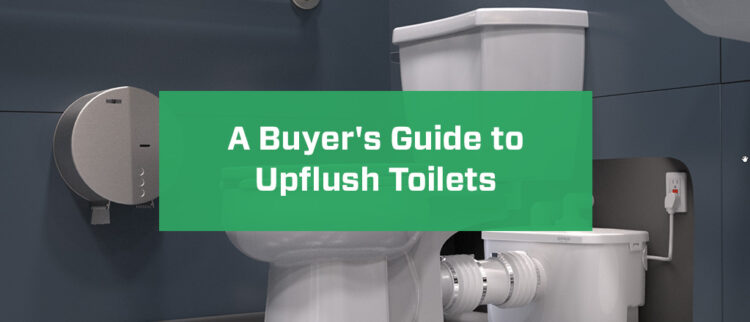
Adding a basement bathroom to your house can increase its value and create a more convenient space for you and your family. Enhance your basement with a bathroom and transform it into a comfortable and inviting living or entertaining space. Whether you use your basement as a guest bedroom or a place to host gatherings, people can conveniently use the restroom without walking upstairs when you install one.
If you want to put a bathroom in your basement, understanding the process and considering essential factors is an excellent starting point. A basement bathroom requires proper ventilation, drainage, lighting, flooring and permits. You can save time and money by following helpful tips and investing in an instant toilet system, which allows you to install a basement bathroom with no plumbing modifications. Adding a bathroom to your basement is a fantastic way to enhance your home.

Benefits of Installing a Basement Bathroom
Enjoy the following advantages with a basement bathroom.
Increased Comfort and Convenience
Adding a bathroom to your basement makes your home more comfortable. A bathroom conveniently located in the basement makes it easier to host family gatherings and parties, and it transforms your basement into a cozier, more inviting space.
Ability to Create a Living Space
The ability to transform your basement into a living area is another benefit of installing a bathroom. Whether you often host overnight guests, plan to monetize your house by renting part of it out or want to create a comfortable place for a family member to live, a bathroom installation is an excellent way to accomplish these goals.
Higher Return on Investment
A basement bathroom can significantly add to your home’s value. While installing a bathroom incurs some costs, it typically multiplies your home’s price if you decide to sell. A basement bathroom that meets codes and regulations can attract potential future buyers and increase the amount of money your home sells for.
Tips for Adding a Bathroom to Your Basement
You can make the basement bathroom installation process smoother by understanding what goes into bathroom installation and the decisions you should make before starting your project. Before installing a bathroom in your basement, consider the following tips.
1. Schedule an Inspection
Call a home inspector before you begin installing your basement bathroom. A professional can ensure your home’s electrical wiring, framework and plumbing system are in good condition before installing fixtures, laying flooring and constructing walls.
2. Determine Your Budget
Figure out your budget before starting your basement bathroom project. Budgeting will help you choose your bathroom features and stay within your means during the process. Once you determine how much you want to spend on a basement bathroom, you can start choosing specific features. Consider the following costs.
- Labor fees: You’ll probably want to hire a professional to handle most or all of your installation work, which can vary between $1,000 and $10,000.
- Plumbing: A significant factor affecting labor costs is plumbing and the fixtures you choose, such as toilets, sinks and showers. Choosing an instant toilet system can eliminate the need for complex plumbing modifications and reduce plumbing costs.
- Electrical labor: You also need to consider electrical costs. Electrical labor can cost between $500 and $2,500, depending on your basement’s current wiring and your specific needs.
- Lighting: Lighting fixtures vary in cost based on your preferences. Plan to spend between $150 and $900 on lighting to give your bathroom the appearance and glow you desire.
- Flooring: Bathroom flooring typically costs between $900 and $3,000.
- Ventilation: Average bathroom ventilation installation costs are between $240 and $548.
- Drywall: Drywall and framing can cost between $1,000 and $3,000, according to your bathroom’s size.
- Vanity: A vanity provides you with a combined sink and counter space. Vanities can cost between $500 and $4,000.
- Faucets: Faucets typically cost between $150 and $350.
- Permit: Obtaining the proper permit to add a bathroom to your basement can cost between $50 and $2,000.
3. Decide if You Want a Full Bath or a Half-Bath
Once you determine your budget, you can decide if you want your new basement bathroom to be a full bath or a half-bath. A half-bath contains a toilet, but a full bath contains a toilet and a shower.
While a full bath allows household members and guests to shower in the basement, it is more expensive than adding a half-bath. It also requires additional installation. A half-bath is an excellent option if your budget will only cover the installation costs to add a toilet and other minor fixtures.
4. Consider What You Can Handle
While your budget is a critical factor, you should also determine the project difficulty level you can handle. Consider each bathroom feature you want to add, such as a shower, toilet, lighting, flooring, new walls and ventilation. While the idea of completing the project by yourself may be tempting, hiring professionals is essential unless you have specific bathroom installation experience.
A plumber can correctly install your bathroom fixtures and run water supply lines to each one. They can also install your chosen drainage system. Additionally, you’ll need to hire an electrician to add wires running from your home’s electrical box to your basement bathroom. These wires provide power to outlets, baseboard heaters and lighting fixtures.
You should also hire a carpenter for your basement bathroom project. They can construct any walls you need and lay your bathroom flooring.
5. Hire the Right Professionals
Since DIY bathroom installation is impractical, you’ll want to hire professionals. Plumbers and electricians with lower rates can help you stay within your budget, but you should also consider their experience and the quality of work they offer.
Check online reviews to ensure the technicians you choose provide consistently high-quality service. Hiring experienced professionals to install your basement bathroom helps it last longer and prevents damage, so you can avoid paying for costly repairs in the future.
6. Plan Your Layout
Before starting the installation process, decide where each fixture will go in the basement bathroom. Consult with your hired professionals to determine where each fixture can fit and function well. Having a plan eliminates the need to make changes later in the process.
7. Determine Wall Locations and Measurements
Part of planning your layout involves where you will construct your basement bathroom walls. If walls are already in place, you can work with the space you have. However, you may need to add walls or replace them if they provide inadequate space for the bathroom fixtures you wish to install or the basement lacks an individual room space.
If you need to add or replace walls, hire an experienced carpenter unless you have experience in this process. The carpenter you hire should measure and mark the floor where they will construct the walls.
8. Obtain Permits
Permits ensure you comply with your county, city or state codes. Ensure you or your contractor obtain the proper permits to complete the work you plan to do. If a potential contractor says permits are unnecessary, hire someone else.
You can learn more about your area’s requirements by contacting your local building authority. You should also collect information about deed restrictions, zoning ordinances and any regulations you may need to follow.
9. Install Quality Flooring
Ceramic tile flooring is the best option for bathrooms because it’s durable, water-resistant and stain-resistant. It’s also a great choice because it doesn’t absorb odors or bacteria, making it an easy-to-clean surface. Ceramic tile varies in size and color, so you can choose a pattern that fits your style.
You should also install an uncoupling membrane under your tile floor. An uncoupling membrane goes between your tile flooring and your basement’s concrete floor to keep the two materials separate. Temperature fluctuations cause concrete to contract and expand naturally, and an uncoupling membrane can prevent the concrete from cracking your tile floor.
10. Choose the Right Lighting Fixtures for Your Space
A basement bathroom may have limited space. Lighting brightens your bathroom without using too much of the room’s valuable space. Recessed lighting fixtures are excellent options because they provide plenty of light, and you can install them in your bathroom’s ceiling.
Consult with an electrician before choosing any lighting fixtures. An electrician can recommend your best options based on your basement’s existing electrical system or electrical possibilities. Installing your basement bathroom as close to any existing electrical systems as possible can streamline this part of the process and possibly save you money.
11. Add Ventilation
Ventilation is crucial in a basement bathroom. Vents direct moisture and odors outside your home and improve your basement’s air quality. Adding proper ventilation to your bathroom ensures humidity from your water fixtures does not cause water damage.
Shower steam can cause condensation buildup in your basement and lead to complications such as wall damage and mold, so adequate ventilation is an essential part of basement bathrooms. Ventilation is especially vital in a basement bathroom because local building codes typically require bathrooms without windows to contain vent fans.
Various options allow you to choose a bathroom vent based on how it activates. While most fans are switch-activated, you can also choose a fan that activates via a humidity sensor, motion sensor or timer.
12. Determine How You Will Add a Toilet
You can save time and money on your basement bathroom by choosing an instant toilet system over a traditional toilet. Conventional toilets can require complex plumbing modifications, especially if your basement lacks plumbing when you start your project. You can use existing plumbing by placing your bathroom as close to it as possible, but not all basements have existing plumbing.
Standard plumbing systems depend on gravity to drain water and waste out of homes. The main sewer line must be below any fixtures like showers, toilets and sinks for them to drain correctly. If a home’s plumbing depth is not low enough, a basement bathroom requires alternative drainage options.
Older homes typically contain main sewer drains that are higher than the basement level. These homes usually need a sewage ejection system for a traditional toilet installation. A plumber installs a sewage ejection system by cutting a sump hole in your basement floor to hold the system. The sewage ejector’s macerating system sits in the sump hole and grinds waste before mixing it with water upon flushing and pumping it through a pipe connected to the main waste drain.
Plumbing modifications require professionals to break through concrete, increasing labor costs and the time it takes to complete your bathroom. Installing an instant toilet system eliminates the need to break concrete and run drainage lines.

How Can the Powerflush Optima Save You Time and Money?
Adding a bathroom to a basement requires a toilet installation, which can be simple or complex, depending on your chosen method. While installing a traditional toilet plumbing system requires a plumber to break concrete, an upflush toilet system can save you time and money.
The Powerflush Optima Pro is an instant toilet system that transfers sewage and wastewater upward. Its tank system can push sewage and wastewater up to 20 feet, allowing it to properly drain your bathroom fixtures to the main sewer line without gravity or a complex sewage ejection system. It allows you to save money on complicated plumbing modifications.
When you install a Powerflush Optima Pro, you can choose between hidden and exposed installation. For hidden installation, you can conceal the system in the wall. If you choose exposed installation, the system sits behind the toilet, so it is still in view but conveniently out of the way. You can also connect other fixtures such as a shower and sink to the Powerflush Optima Pro, allowing you to install a full bathroom without breaking concrete.



